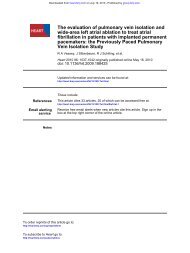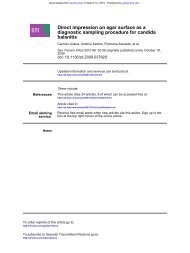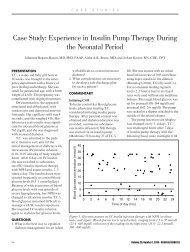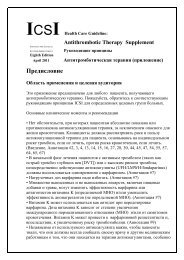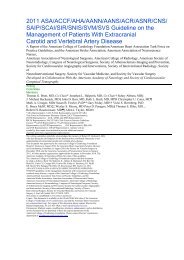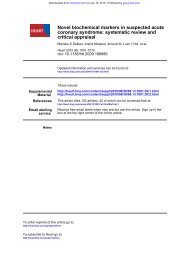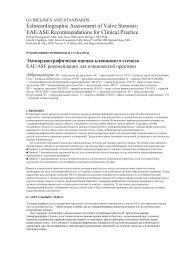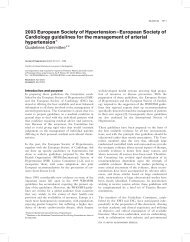echocardiography: basic principles Two dimensional speckle tracking
echocardiography: basic principles Two dimensional speckle tracking
echocardiography: basic principles Two dimensional speckle tracking
You also want an ePaper? Increase the reach of your titles
YUMPU automatically turns print PDFs into web optimized ePapers that Google loves.
Education in Heart<br />
Table 2 Mean left ventricular circumferential and radial peak systolic segmental strain<br />
values calculated from 60 healthy subjects aged 39615 years by Hurlburt et al 15<br />
LV segment (short axis view<br />
at a basal level, just below<br />
mitral valve)<br />
Downloaded from<br />
heart.bmj.com on May 1, 2010 - Published by group.bmj.com<br />
Mean peak systolic<br />
circumferential strain<br />
(%)±SD<br />
Anterior 2466 39616<br />
Lateral 2267 37618<br />
Posterior 2167 37617<br />
Inferior 2266 37617<br />
Septal 2466 37619<br />
Anteroseptal 26611 39615<br />
Mean peak systolic<br />
radial strain<br />
(%)±SD<br />
Scanner: Vivid 7, GE Medical Systems. Software: EchoPac Advanced Analysis Technologies, GE Medical<br />
Systems.<br />
Figure 7 Longitudinal strain curve with peak longitudinal strain occurring in early<br />
diastole. AVC, aortic valve closure; N, peak systolic longitudinal strain.<br />
This suggests that EF and STE strain reflect<br />
different parameters of systolic LV function. Thus,<br />
STE strain provides information on top of LVEF. 31<br />
Figure 8 Displacement of acoustic markers from frame to frame. Green dots represent<br />
the initial position and red the final position of the <strong>speckle</strong>s.<br />
Deformation and diastolic function<br />
Diastolic dysfunction in patients with normal<br />
systolic function results in impaired myocardial<br />
relaxation and reduced filling of the left ventricle<br />
during early diastole. This state is reflected by<br />
a change of the early diastolic LV (un-) twist<br />
pattern. 9 A decrease of early diastolic apical<br />
untwisting rate (rotR) as well as a shortening or<br />
negativity of time from peak apical diastolic<br />
untwist to mitral valve opening (trotR to MVO) can<br />
be observed (figure 10). 10<br />
Thereby, rotR and trotR to MVO both become less<br />
as diastolic dysfunction progresses. RotR correlates<br />
well with established parameters of diastolic<br />
dysfunction like early diastolic tissue velocity of<br />
septal mitral annulus (e’) and ratio of early diastolic<br />
mitral inflow to tissue velocity of septal mitral<br />
annulus (e:e’). 10<br />
LIMITATIONS OF 2D STRAIN<br />
< Image quality: Even though 2D STE is fairly<br />
robust, image quality is still an issue. In young<br />
healthy subjects, approximately 6% of all LV<br />
segments cannot be analysed due to poor image<br />
quality. 15<br />
< Out of plane motion caused by movement of<br />
the heart during the cardiac cycle: It is unclear<br />
how out of plane motion of <strong>speckle</strong>s and frame<br />
You can get CPD/CME credits for Education in<br />
Heart<br />
Education in Heart articles are accredited by both<br />
the UK Royal College of Physicians (London) and the<br />
European Board for Accreditation in Cardiologydyou<br />
need to answer the accompanying multiple<br />
choice questions (MCQs). To access the questions,<br />
click on BMJ Learning: Take this module<br />
on BMJ Learning from the content box at the top<br />
right and bottom left of the online article. For<br />
more information please go to: http://heart.bmj.<br />
com/misc/education.dtl<br />
< RCP credits: Log your activity in your CPD diary<br />
online (http://www.rcplondon.ac.uk/members/<br />
CPDdiary/index.asp)dpass mark is 80%.<br />
< EBAC credits: Print out and retain the BMJ<br />
Learning certificate once you have completed<br />
the MCQsdpass mark is 60%. EBAC/ EACCME<br />
Credits can now be converted to AMA PRA<br />
Category 1 CME Credits and are recognised by<br />
all National Accreditation Authorities in Europe<br />
(http://www.ebac-cme.org/newsite/?<br />
hit¼men02).<br />
Please note: The MCQs are hosted on BMJ<br />
Learningdthe best available learning website for<br />
medical professionals from the BMJ Group. If<br />
prompted, subscribers must sign into Heart with<br />
their journal’s username and password. All users<br />
must also complete a one-time registration on BMJ<br />
Learning and subsequently log in (with a BMJ<br />
Learning username and password) on every visit.<br />
720 Heart 2010;96:716e722. doi:10.1136/hrt.2007.141002


